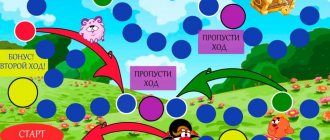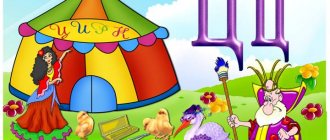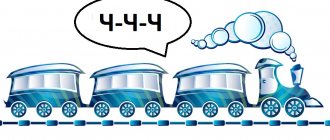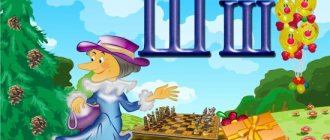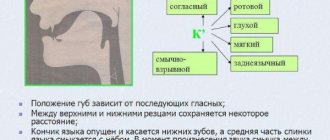Pupils of the speech therapy group who need correction of the sound culture of speech may experience difficulties with the pronunciation of not only hissing and whistling sounds, but also labiodental ones, in particular [c]. Automation of sound [in] is one of the stages of correctional work necessary to eliminate deficiencies in the reproduction of a given sound in speech.
What is sound automation?
Speech therapy work to eliminate pronunciation deficiencies includes three main stages:
- staging;
- automation;
- differentiation.
Lessons are built sequentially. Without completing the first step, you cannot proceed to the second and beyond.
Of all three stages of sound pronunciation correction, the most extensive is the second - automation. At the stage of staging, as a rule, if there are no serious problems, the sound can be delivered mechanically with the help of special speech therapy probes even in a couple of sessions - everything will depend on a number of factors accompanying the development of the child’s speech. At the differentiation stage, if phonemic perception and hearing are not impaired, the work is also carried out quite quickly. In this case, games and exercises are used to distinguish paired sounds [v] - [f].
The period of automation is complex, since the organs of articulation must get used to a new position not only when pronouncing a sound in isolation, but also in syllables, and then in words during the child’s free speech.
Speech therapy lesson “NOD. Sounds V, V, letter V"
Municipal budgetary preschool educational institution
“Kindergarten No. 9 “Sun” combined type
Direct educational activities in a speech therapy group preparatory to school in the educational field “Communication”
Subject. Sounds V, V, letter V.
Author
teacher speech therapist
Kozlovskaya Galina Dmitrievna
Prokopyevsk 2013
GCD theme. Sounds V, V, letter V.
Integration (GCD):
(“Communication”), (“Health”), (“Socialization”)
Tasks:
- consolidate work methods for the development of phonemic perception based on the use of elementary and complex forms of phonemic analysis in the course of various types of activities with the sounds B, B; ("Communication")
- promote the development and normalization of the emotional-volitional sphere through the activation of motor kinesthesia, exercises for the development of prosodic components of speech; ("Health")
- strive to develop the communicative qualities of an individual through the use of various methods of children’s activities; ("Socialization")
- demonstrate the results of joint work with parents to prepare children for school. ("Socialization")
Materials and equipment:
a panel depicting the sun and sunbeams, non-speech support “Consonants”, pictures - symbols for pronouncing isolated sounds V, V, sound sounds V, V, sound pencil cases, plumes, wind blowers, mini-pools with sand, pictures in a contour image in a noisy form, colored pencils (red, green, blue), puzzles, a key with the letter B, stars, symbols of smart guys and smart girls.
Methodical techniques:
ritual of starting classes, didactic exercises, guidance in viewing and analyzing objects and pictures, story - reasoning using visual non-verbal support, work with sound patterns, game motivation, did. games, dynamic pause, solving puzzles, explanation from a speech therapist.
Preliminary work:
memorizing chants, games to form a directed air stream, games with sand, solving puzzles.
The logic of direct educational activities.
I
.
Organizing time
.
1. Zaklichka with elements of psycho-gymnastics
(In a circle).
Speech therapist.
With the onset of spring, in the old days people often called for the sun to visit.
- What does “call out” mean?
(
call, invite
)
Let's invite the sun to visit.
Children.
“Hello, bell sun!
Come visit us!
We have to get up early
Let's welcome spring!
A panel opens, depicting the sun with sunbeams. (The number of sunbeams corresponds to the number of students participating in the NOD. They can be removed from the picture.) On the back side of the sunbeams there are object pictures glued (group 1: cotton wool, water, owl, sofa cow, diver; group 2: button, fork, grapes) and printed words (stolen, wind, sounds). (Annex 1.)
Speech therapist.
The sun wants to tell us something. Everyone left their own
Hello - sunbeam. Consider it.
2.Did. exercise “Find out what the sunbeam wants to communicate?”
Speech therapist. To find out what the sun wants to communicate, you first need
divide into three groups.
(The division into groups can be carried out on the basis of a differentiated approach: pupils who can read; according to the social principle: boys - girls; according to interests).
Each group must complete the task:
- read the words on the back of the pictures and make a sentence from these words;
(The wind stole the sounds.) - name the words from the pictures, think about what identical sound is hidden in the words:
cotton wool, water, owl, sofa cow, diver? (Sound B) - name the words from the pictures, determine what identical sound is hidden in the words:
button, fork, grapes? (Sound V)
II. Introducing the sounds V, V.
Speech therapist. The wind stole the sounds V and V from the land of beautiful and correct speech
Chrysostom and the letter B from the ABC. He was offended that he was not invited to
guests. After all, he helps us pronounce sounds.
By participating in the duel of experts “Clever girls and smart guys”, we will be able to return sounds and letters.
Each correct, original and smart answer is rated with a red asterisk, for a good answer - a blue asterisk, a gray asterisk means that you need to try.
1. Characteristics of the sounds B and Bb according to acoustic-articulatory characteristics.
A. Let's talk about the sounds B and B.
“Pomogalochka” will help us. (Appendix 2)
Lightly touch your upper teeth to your lower lip. Say the sound B.
- What is his last name?
(Sound B is a stirrer, he cannot sing. His upper teeth prevent him from singing, so he is a consonant. His last name is Consent.)
Place the back of your hand on the neck.
- Is the voice sleeping or ringing? (The bell rings.)
- Voiced or dull sound?
(Voiced) - What do you think is the character of the B sound?
Soft or hard? (Hard)
What kind of suit does he wear?
(Blue)
Name the full name of the sound V. ( Consonant, voiced, hard)
Say his brother in each other's ears. (Sound V)
- What kind of suit does he wear?
(Sound V wears a green suit.)
b. Game “One, two! Turn around and turn into sound!”
Girls turn into the sound V, and boys into the sound V.
On the table the children have suits of vowels and consonants, hard - soft, voiced - dull sounds. Everyone find their own suit and put it in a green or blue hoop.
2. The game “Windmills - screamers”.
Two teams play.
Take the plumes (team 1) and wind blowers (team 2) in your hands and start blowing at a count of 1-2. Make sure your shoulders don't rise.
Then clearly, without errors, repeat the screaming and winding. First, the whole team speaks, and then a representative from the team.
1 boys team
(Say it quietly.)
Woo - woo - woo, woo - woo - woo,
— Vasilkov bouquet to Narva.
2nd team
of girls ( Report so that everyone can hear.)
Vi - vi - vi, vi - vi - vi,
- Just don’t tear them too much.
3. Game "Hide and Seek".
The breeze wants to play hide and seek with you.
A. Passive-active gymnastics “Finger pool”.
Mini-pools with sand are brought in. 2 teams play.
There's something hidden there.
You need to find it by completing the following tasks:
- use a pinch of sand to depict winding a thread around a ball;
- write the vowels A, U, O, I, Y, E with different fingers.
At the bottom of the pools there is a package with pictures in outline images of objects . (The number of pictures corresponds to the number of pupils)
b. Didactic exercise “Find out which sound V or V is hidden in the word?”
- Recognize an object in a noisy contour image. Determine which named sound is hidden in the word. Paint the suit with the appropriate color in the desired cell (beginning, middle, end of the word).
Words: cow, vase, fork, tree, TV, star;
fork, button, letters, wolf, vase, cow.
(At the bottom of the pictures is a strip divided into three parts (beginning, middle, end.
4.Dynamic pause
(To music)
- Depict how the wind shakes the trees in the forest and they groan;
how birds fly and flap their wings, feeling the breeze running through their wings .
(Children pronounce the sounds V and V).
Let's turn into birds and fly.
- Remember the birds whose names contain the sounds V or V.
(
Sparrow, crow, owl)
5. Sound analysis of the word “Owl”.
- Open the sound pencil cases and lay out the diagram of the word. In the name of this bird, the B sound is in the middle.
(Sound pencil cases are pencil cases in which there are red chips to indicate vowel sounds, blue with a bell - for hard voiced consonants, blue without a bell - to indicate hard voiceless sounds, green with a bell - for soft voiced consonants, green without a bell - to denote soft voiceless consonants. When conducting phonemic analysis, the diagram of the sound composition of the word is filled with colored chips
.
Strong children work at desks, one at an easel, the rest on the ground.)
Children must divide the word into syllables, arrange the syllables into sounds, pronounce the word by sounds, name vowels and consonants).
7. Working with puzzles.
Decipher the puzzles.
- What is this?
(Letter O) - Find out what words are hidden in O?
Notice how I asked: “Hid in
O
”?
So you will answer: “ In O and further you name the letters
.”
Pictures of an ox and a wolf are displayed.
- What is the difference between an ox and a wolf?
(A wolf is a wild animal, and an ox is a domestic animal).
Make up sentences with the words ox and wolf using the diagrams.
1 ______ _______ . 2 ______ ________ _______.
- Solve the following puzzles
.
III. Introducing the letter V.
When solving puzzles, you cast a spell so that the letter key B appears.
- About
When are automation measures necessary?
If the child pronounces [in] in isolation and articulates it correctly, then the production stage can be considered completed - now it is necessary to automate the sound. For this, some time must pass, a kind of sound “working out” must be completed. In some cases, children quickly incorporate the correct pronunciation into their speech, but this happens more often when the sound was introduced from scratch. But if it was necessary to correct incorrect sound pronunciation, to which the child has already become accustomed, then the speech therapist will have to take automation measures.
Lesson notes “Sound B”
Goal: to develop the skill of pronunciation [B] in reverse syllables, at the end of words.
Tasks:
- consolidate the pronunciation of words in which the sound is at the beginning of the word, in straight syllables;
- use techniques of reflected repetition, independent naming of words from a picture;
- use tasks that direct the child to independently search for words containing [in];
- develop creative thinking;
- maintain interest in speech therapy classes.
Equipment: magnetic board or interactive whiteboard, paper figures with magnets.
Progress of the lesson.
I. Organizational moment.
— Guys, do you like fairy tales? — Would you like to be storytellers yourself?
The speech therapist puts on a fairy hat, picks up a magic wand, waves it:
- Krible! Crable! Boom! You are storytellers! Now let's get down to business.
II. Consolidation of what has been learned.
1. Articulation gymnastics.
- Once upon a time there were the sounds B and B'. What sounds are these? Vowels or consonants? Voiced or voiceless?
The sounds were friendly. They really loved delicious jam. Let's show how they ate it. Exercise “Delicious jam”.
2. Finger gymnastics.
They lived in a small town, in a small house. There is a house in a clearing, draw “House” with two hands, the roof of the house - the fingers of the left and right hands touch.
Well, the path to the house is closed. The right and left hands are turned with their palms facing themselves, the middle fingers rest against each other, the thumbs point upward (“gate”).
We open the gates, Palms parallel to each other.
We invite you to this house. Show “house” with two handles, the roof of the house - the fingers of the left and right hands touch.
3. Repeating the pronunciation of [B] in straight syllables.
Arrived at kindergarten (a sparrow figurine appears)…. Children: sparrow!
- Right! Sparrow. And he brought (an image of a scroll in a beak) a letter.
Let's see what is being said here. The brothers loved to travel. They went to the country of Imagination to their cousins [F and [F'] on a (picture) steam locomotive.
We got into the (picture) carriage and drove off. Whether long or short, they arrived at the (picture) station in the land of Imagination. They got out of the carriage, walked along the city streets, and brother [B'] lost brother [B].
Children name what is shown in the pictures. — Guys, the sound [B'] asks us for help. Helps you find your lost brother.
III. Automation of sounds in syllables.
What needs to be done to find him? We need to say it more often. Va-va-va-avav-ava-ava. Woo-woo-woo woo-woo-woo. You-you-you-you-you-you. Whoa, whoa, ovo, ovo, ovo.
IV. Automation of sounds in words.
Va-va-va my head was spinning. Woo-woo-woo I call my brother. I really don't understand anything. Ov-ov-ov no traces can be found. Ovy-ovy-ovy, both are ready to cry. “That’s how hard it was for the brothers.”
V. Physical exercise.
- Our magic bell will help us find the way, You just need to shake it a little first. And then don’t lose heart and follow the commands. Turn right (heads turn right)
And then to the left (head to the left). Directly in front of you is the Queen's castle (hands up). We walk together (walk in place), we need to hurry (run in place),
Our muscles will become stronger and more elastic. We open the gate (arms to the sides), Someone is waving at us (waving their arms). We were lost and found. We met and hugged (hug yourself with your arms).
VI. Game "Give me a word."
- Our fairy tale has come to a happy ending. The brothers found each other and decided to play a game. • One steam locomotive pulls and pulls onto the platform... a carriage.
• The little boy sat down in the living room on a huge... sofa.
• There is grass growing in the yard, There is... firewood on the grass.
• Very scary and fidgety. Boa constrictors crawl in the jungle.
• It is difficult for both tourists and tramps to overcome... ravines.
VII. Game “What sounds around us?”
- Look how many objects there are in this room, they all have names - these are words that sound. For example, I found the word “call”. Listen to how it sounds: call].
The speech therapist asks one of the children to repeat this word so that all sounds are heard very clearly. Then he asks him to find another word with the sound B, which is hidden in the room, and pronounce it so that the sounds are heard.
Next, he offers to repeat the word the child found to the next player, and so on.
During the game, the teacher monitors the clarity of the children’s pronunciation of words. If the child finds it difficult, you need to give him a hint. Words that a child can find in the group: cornflower, wolf, sleeve, head, bath, vase, cook, mitten, lapel, turn, crow, sparrow.
VIII. Summary of the lesson.
- What sound were we talking about today? - What is he like? -What good deed have we done?
Difficulties in production [c]
Problems during sound production can be completely different, the main ones include the following:
- Weak innervation of the muscles of the speech apparatus. This is expressed in the fact that due to insufficient muscle tone of the organs of articulation (in particular the vocal cords, since they play the main role in the pronunciation of a given sound), the child simply cannot pronounce the sound. Without the participation of the voice, it turns out [f] instead of [v]. It will take time to develop connections so that the pronunciation is clear and correct.
- Malocclusion. This fact can also influence and give its complications in the staging [c], but this does not always happen.
- Lip defect. When pronouncing “B”, not only the teeth are involved, but also the lips. A short or drooping lower lip can make sound production difficult.


